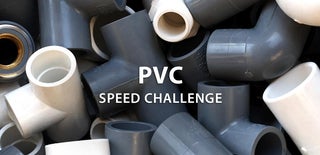Introduction: PVC Portable Projector Screen
I recently got a small projector to use when we go camping, so I needed a screen to use with it, but I wanted to make one I could dismantle and transport easily. The simplest materials are the best so I decided to use PVC pipe and connectors. No glue is needed for this build as the connectors are quite a tight fit and the joints that need securing will be held together with small screws .
Supplies
For the projector screen, you will need
- White sheet or a pre-made fabric screen I got a cheap one from AliExpress see the example image
- 25mm PVC pipe
- 6 T-piece connectors
- 2 Corner connectors
- A few small screws
The lengths I used of the pipe were relative to the size of the screen you have, I just got the smallest one for the least amount of money keeping in mind that it also had to fit in a tent when up.
Tools:-
- Basic pipe cutter - if you have a proper PVC cutter so much the better, I only had one for copper pipe but it worked great
- Tape measure
- Screwdriver (powered or not)
Step 1: Construction
It must be possible to take the screen apart for storage, but I don't want to have to build it all each time I want to use it, so Im going to secure a few of the joints using small screws as I go. The push-fit on the joints is quite tight so the remaining joints don't require screws.
Starting from the ground up I cut:-
- 4 lengths 30 cm long and made two feet with a T joint in the middle of each.
- Onto each foot, I put a 50 cm length of pipe (no screws this time).
- I then needed two lengths approx 70cm with a T joint at one end held with a screw - these will start to make the bottom of the screen frame.
- Each side was just a length of pipe 90 cm long.
- On each side, for the top, I used a 70 cm length with a corner joint at one held with a screw.
- To hold both sides of the frame together you need a bit of pipe approx 90.5 cm long with a T joint at each end held with a screw. The joints must in the same orientation to each other so the frame is not misshaped.
Step 2: Attach the Screen
The screen comes with eyelets at each corner, a length of black string, and a load of sticky-backed hooks. Initially, I was going to use the hooks by removing the plastic backing and drilling holes to the pipe to insert the metal hook. I tried a few test pieces, but they didn't look right and were hard to attach. So I moved on to picture frame fixings, the kind that has a loop of wire with a fold-over tab to screw in place.
These worked fine so I attached the fabric using the string supplied, one length for each side and used a slip knot so that I could adjust the tension on the fabric. Again this did the job BUT - the string made it a bit fiddly, especially if I wanted to quickly put it up or down, and the picture fixings haled the fabric close to the frame meaning that it was hel aginst the center upright support of the frame, so improvements where needed.
Step 3: Improvements
The answers were
- To hold the fabric off of the frame took two parts. A threaded eye (this needed the thread shortening to fit the next part) and the second part was one side of those connectors you use to hold kitchen cupboards together. I found (luckily) that the tread was the same as that of the eyes. So I removed the picture fixings and drilled through the corners of the frame, starting with a drill bit just large enough for the thread on the eye. I then increased the size of the hole on the rear of the joint to take the cupboard connector. Pushed the connector through which was not long enough to go all the way to the other side and threaded the eye into it from the front (see images).
- To replace the string I started with some wire and mini carabiners, but this still had the issue of tensioning the fabric so I replace this with retractable keyring clips and elastic. This let me set the right amount of tension to hold the screen, it was quick to unclip and was something that could be left on the eye so I wouldn't lose it.
Step 4: Using the Finished Screen
The screen works really well, and because of its design can be used in two different formats. this gives you a large screen and a smaller one.
For the large screen, you just put it up as described in this guide. If you need a slightly smaller one you just need to remove one of the sides, rotate the frame around, and put the legs into the side (easier to see if you look at the pictures.
You then just attach the fabric to what is now the top and fold it under the pipe at the bottom. You will need to use string or elastic to pull it taught from the rear. I have still to make the elastics for this format, but there is no rush as I want it in the large screen setup for now.
I hope you have enjoyed reading this guide, and if you like it please consider voting for it in the PVC competition
Thanks for reading

Participated in the
PVC Speed Challenge













